
Answer
102k+ views
Hint: The above compound is known as tetrathionate. Other species of sulfur at intermediate oxidation state, such as thiosulfate, tetrathionate can be responsible for the pitting corrosion of carbon and stainless steel.
Complete step by step solution:
The tetrathionate anion is a sulfur oxo anion derived from the compound tetrathionic acid. You might know that tetrathionate has been found to serve as a terminal electron acceptor for Salmonella enterica serotype Typhimurium, whereas existing thiosulfate in the lumen of mammals is oxidized by reactive oxygen species released by the immune system to form tetrathionate. This aids in the growth of the bacterium, helped by the inflammatory response.
Now, to answer our question, Consider the structure of tetrathionate given in the question. The two central sulfurs each have two lone pairs and are assigned half of the electrons from the two bonds they make with oxygen since the electrons of covalent bonds between atoms of the same element must be distributed evenly (because electronegativity difference is zero between two atoms of the same element). A neutral sulfur atom has six valence electrons, so the oxidation state of the central sulfurs is equal to 0. That is, six electrons in neutral sulfur, minus four from the lone pairs, minus half of the four S-S bonding electrons, gives zero.
On the other hand, the terminal sulfurs have no lone pairs, and all the electrons from the sulfur-oxygen bonds are assigned to oxygen since it is more electronegative than sulfur. The only electrons assigned to those sulfurs are half of those from the sulfur-sulfur single bond. Hence, their oxidation state is 5. That is six electrons in neutral sulfur, minus half of the two S-S bonding electrons, giving an oxidation state of +5.
Therefore, the correct answer is (C)- +5, 0, 0, +5.
Note: In this type of questions, you must know the electronegativity of the elements (not the exact value but a rough idea about whose electronegativity is greater or lesser) to determine the direction of accumulation of electrons.
Complete step by step solution:
The tetrathionate anion is a sulfur oxo anion derived from the compound tetrathionic acid. You might know that tetrathionate has been found to serve as a terminal electron acceptor for Salmonella enterica serotype Typhimurium, whereas existing thiosulfate in the lumen of mammals is oxidized by reactive oxygen species released by the immune system to form tetrathionate. This aids in the growth of the bacterium, helped by the inflammatory response.
Now, to answer our question, Consider the structure of tetrathionate given in the question. The two central sulfurs each have two lone pairs and are assigned half of the electrons from the two bonds they make with oxygen since the electrons of covalent bonds between atoms of the same element must be distributed evenly (because electronegativity difference is zero between two atoms of the same element). A neutral sulfur atom has six valence electrons, so the oxidation state of the central sulfurs is equal to 0. That is, six electrons in neutral sulfur, minus four from the lone pairs, minus half of the four S-S bonding electrons, gives zero.
On the other hand, the terminal sulfurs have no lone pairs, and all the electrons from the sulfur-oxygen bonds are assigned to oxygen since it is more electronegative than sulfur. The only electrons assigned to those sulfurs are half of those from the sulfur-sulfur single bond. Hence, their oxidation state is 5. That is six electrons in neutral sulfur, minus half of the two S-S bonding electrons, giving an oxidation state of +5.
Therefore, the correct answer is (C)- +5, 0, 0, +5.
Note: In this type of questions, you must know the electronegativity of the elements (not the exact value but a rough idea about whose electronegativity is greater or lesser) to determine the direction of accumulation of electrons.
Recently Updated Pages
Write a composition in approximately 450 500 words class 10 english JEE_Main

Arrange the sentences P Q R between S1 and S5 such class 10 english JEE_Main

Write an article on the need and importance of sports class 10 english JEE_Main

Name the scale on which the destructive energy of an class 11 physics JEE_Main

Choose the exact meaning of the given idiomphrase The class 9 english JEE_Main

Choose the one which best expresses the meaning of class 9 english JEE_Main





